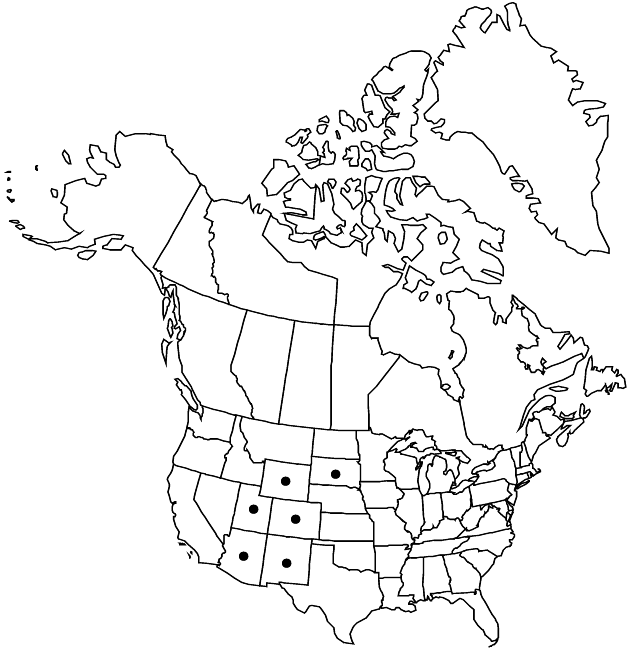Difference between revisions of "Erigeron formosissimus"
Bull. Torrey Bot. Club 25: 121, plate 332, figs. 3, 4. 1898.
FNA>Volume Importer |
FNA>Volume Importer |
||
| Line 17: | Line 17: | ||
}}<!-- | }}<!-- | ||
| − | --><span class="statement" id="st-undefined" data-properties=""><b>Perennials,</b> 10–40(–55) cm; rhizomatous, fibrous-rooted, rhizomes variably thick. <b>Stems</b> ascending, densely hirsute to hirsutulous or glabrous, minutely glandular to stipitate-glandular. <b>Leaves</b> basal (persistent) and cauline; basal blades oblanceolate to oblanceolate-spatulate, 20–100(–150) × 4–10(–15) mm, margins entire, closely ciliate, faces glabrous or sparsely hirsute, sometimes sparsely glandular; cauline blades becoming ovate to lanceolate, gradually reduced distally (bases clasping). <b>Heads</b> 1–6. <b>Involucres</b> 5–8 × 10–20 mm. <b>Phyllaries</b> in 2–3 series (greenish), glabrous or hirsuto-villous, densely minutely glandular to stipitate-glandular (glands sometimes obscured by hairs in < | + | --><span class="statement" id="st-undefined" data-properties=""><b>Perennials,</b> 10–40(–55) cm; rhizomatous, fibrous-rooted, rhizomes variably thick. <b>Stems</b> ascending, densely hirsute to hirsutulous or glabrous, minutely glandular to stipitate-glandular. <b>Leaves</b> basal (persistent) and cauline; basal blades oblanceolate to oblanceolate-spatulate, 20–100(–150) × 4–10(–15) mm, margins entire, closely ciliate, faces glabrous or sparsely hirsute, sometimes sparsely glandular; cauline blades becoming ovate to lanceolate, gradually reduced distally (bases clasping). <b>Heads</b> 1–6. <b>Involucres</b> 5–8 × 10–20 mm. <b>Phyllaries</b> in 2–3 series (greenish), glabrous or hirsuto-villous, densely minutely glandular to stipitate-glandular (glands sometimes obscured by hairs in <i></i>var.<i> formosissimus</i>). <b>Ray</b> florets 75–150; corollas blue to purple, rarely pink to white, 8–15 mm (ca. 1 mm wide), laminae coiling at tips or not at all. <b>Disc</b> corollas 3.5–4.5 mm. <b>Cypselae</b> (1.3–)1.6–1.9 mm, 2-nerved, faces sparsely strigose; pappi: outer of setae, inner of 15–25 bristles.</span><!-- |
-->{{Treatment/Body | -->{{Treatment/Body | ||
| Line 45: | Line 45: | ||
-->{{#Taxon: | -->{{#Taxon: | ||
name=Erigeron formosissimus | name=Erigeron formosissimus | ||
| − | |||
|authority=Greene | |authority=Greene | ||
|rank=species | |rank=species | ||
| Line 57: | Line 56: | ||
|publication year=1898 | |publication year=1898 | ||
|special status= | |special status= | ||
| − | |source xml=https://jpend@bitbucket.org/aafc-mbb/fna-data-curation.git/src/ | + | |source xml=https://jpend@bitbucket.org/aafc-mbb/fna-data-curation.git/src/eaa6e58056e40c9ef614d8f47aea294977a1a5e9/coarse_grained_fna_xml/V19-20-21/V20_762.xml |
|tribe=Asteraceae tribe Astereae | |tribe=Asteraceae tribe Astereae | ||
|genus=Erigeron | |genus=Erigeron | ||
Revision as of 20:30, 16 December 2019
Perennials, 10–40(–55) cm; rhizomatous, fibrous-rooted, rhizomes variably thick. Stems ascending, densely hirsute to hirsutulous or glabrous, minutely glandular to stipitate-glandular. Leaves basal (persistent) and cauline; basal blades oblanceolate to oblanceolate-spatulate, 20–100(–150) × 4–10(–15) mm, margins entire, closely ciliate, faces glabrous or sparsely hirsute, sometimes sparsely glandular; cauline blades becoming ovate to lanceolate, gradually reduced distally (bases clasping). Heads 1–6. Involucres 5–8 × 10–20 mm. Phyllaries in 2–3 series (greenish), glabrous or hirsuto-villous, densely minutely glandular to stipitate-glandular (glands sometimes obscured by hairs in var. formosissimus). Ray florets 75–150; corollas blue to purple, rarely pink to white, 8–15 mm (ca. 1 mm wide), laminae coiling at tips or not at all. Disc corollas 3.5–4.5 mm. Cypselae (1.3–)1.6–1.9 mm, 2-nerved, faces sparsely strigose; pappi: outer of setae, inner of 15–25 bristles.
Distribution

w United States.
Discussion
Varieties 2 (2 in the flora).
Variation in vestiture of Erigeron formosissimus is complex, ranging from stems and heads glabrous and densely stipitate-glandular to stems and heads densely hairy and essentially eglandular; intermediates are found over the range of the species. The taxonomic solution of recognizing broadly sympatric varieties within a single species is biologically untenable, and some have treated this as a single entity; the variation is greater than typically occurs within a single species of Erigeron (see comments following 3. E. neomexicanus, where the situation with E. oreophilus is similar).
Selected References
None.
Key
| 1 | Involucres moderately to densely hirsute, minutely glandular; distal leaves hirsuto-villous, eglandular or sometimes sparsely glandular | Erigeron formosissimus var. formosissimus |
| 1 | Involucres glabrous or sparsely hirsuto-villous, densely minutely glandular; distal leaves usually glabrous, sometimes sparsely villoso-hirsute, minutely glandular | Erigeron formosissimus var. viscidus |